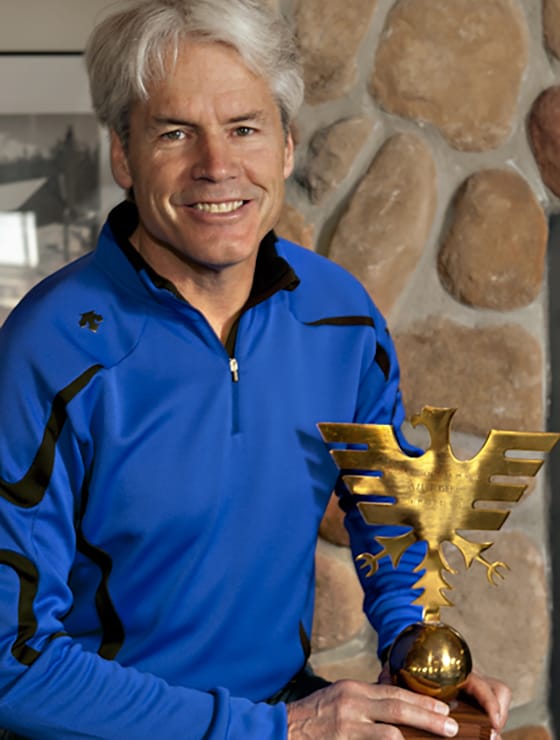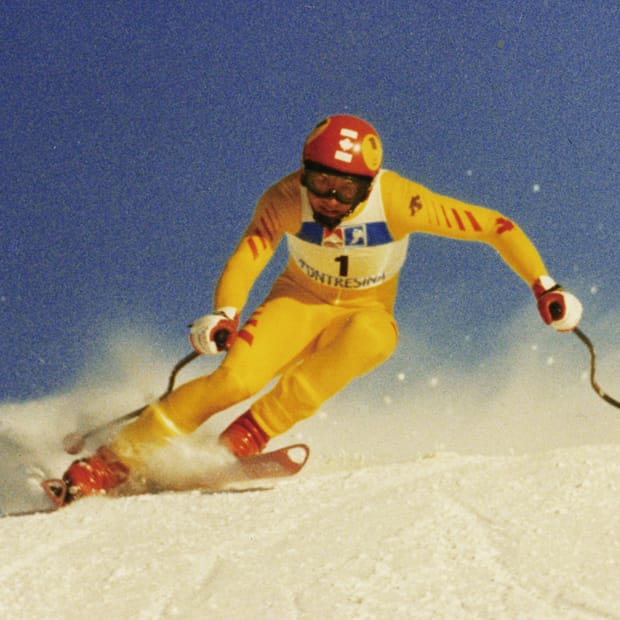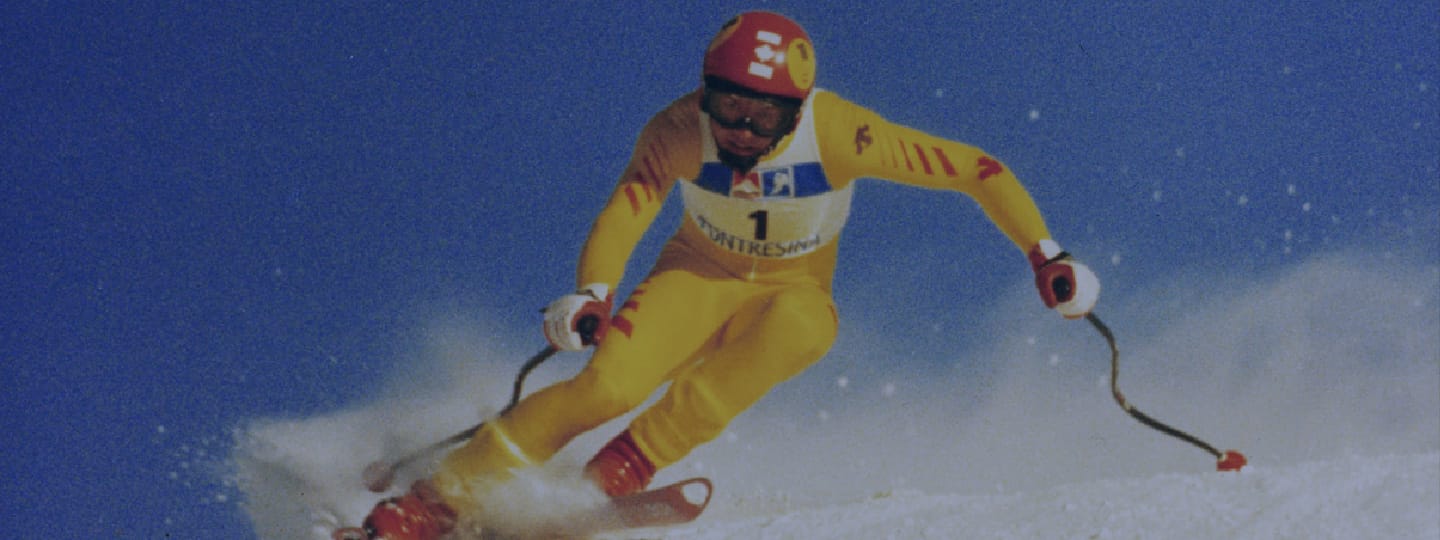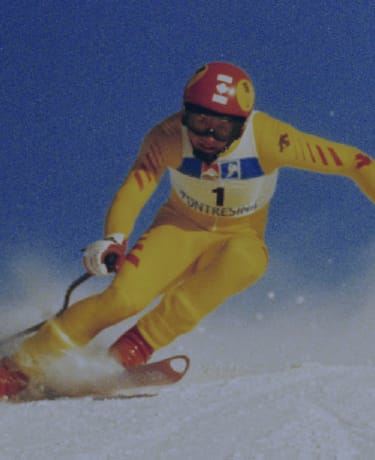
Profile :
The Downhill ski suit is the pinacle of skiwear technology. It is ultimately flexible, wind resistant and comfortable, while offering essential protection from impact and harsh Alpine conditions.
The Swiss sports engineer Hans Hess was appointed to oversee the next stage of the evoltion process that had begun with the Kris Cut suit at Sapporo in 1972. The results was Descente's "Magic Suit" which created a sensation at the 1979 World Cup.
At the fourth World Cup Downhill of the seasn held on January 6, 1979, in Morzine (France), the Canadian Skier Ken Read achieved a stunning victory in a Descente suit.
Interview in July 2011
Interview with Ken Read
Q:
After having had such an impressive career in skiing - winning five World Cup downhill races, and being part of the famous “Crazy Canucks” - what is your most memorable moment from all your years as a ski racer?
A:
Without question, winning the Hahnenkamm at Kitzbuhel in 1980, followed by winning on the Lauberhorn in Wengen, was the highlight of my ski racing career. These two mountains are considered the toughest downhill races in the world, and are steeped in ski racing tradition. Each is very different - Kitzbuhel being a tough, demanding track that tests skill, daring and physical capacity, while Wengen is long and subtle and requires experience, stamina and subtlety.
Q:
You were the first North American male to win a World Cup downhill event. What do you remember about that race?
A:
The race was December 7, 1975 in Val d’Isere, France. I had number one, it was my first race in the top seed and I was only 20 years old. My best result to that point in my career had been an eighth place the previous year. Val d’Isere in 1975 had several very intimidating jumps – the ‘Bosse a Collumbin’ where World Champion Roland Collumbin had fallen the year before and ended his career, the Tower Jump, Tunnel jump and Compression jump. It seemed we spent more time in the air than on the snow. As it was the first time racing amongst the best, I took a little too long warming up and was nearly late for my start, rushing to prepare quickly just before moving into the start position. I took this all in stride, was not intimidated and laid down an impeccable run, not letting the number one start throw me off. In retrospect, rushing through my pre-race preparation was a good thing, as I had no time to get nervous and simply focused on giving it everything in my run.
Q:
As the developer and maker of the racing suits worn by the Canadian National Ski Team, Descente was a proud partner of the “Crazy Canucks”. Can you tell us your thoughts about your race suits at the time?
A:
The partnership between Canada and Descente was one that I was very proud of. The suits were like a second skin – fitting perfectly – and we knew that the design, material and aerodynamics were the superior brand on the World Cup circuit. It felt like we had an added boost as we moved into the start of every race.
Q:
You have remained very active in the world of skiing – especially in broadcasting – since retiring from active competition. Was it a hard decision to stop, and has the transition to life after active skiing been a comfortable one for you?
A:
Retirement from sport is tough. For an extended period of time – in my case over twenty years from age seven to 27 – this was my passion, my focus. But sport is a great teacher: focus, dedication, goal setting, critical examination, split second evaluation – a skill set that can be used for a lifetime. Couple these skills with the experience of international sport – business, international markets and networks – which provide unique opportunities in sports journalism through TV broadcasting and writing. While it takes time to make the transition, which returning to university to complete a degree in Economics helped bridge, finding new challenges and dedicating this passion to educating the Canadian public about ski racing and sport became a new focus for me. For 15 years I had the privilege of working with the very best in sports broadcasting with CBC Sports, including the dean of Canadian Olympic sports broadcasting, Mr. Brian Williams and a leader in the business, Mr. Jim Thompson. My parents also influenced my interest in sport beyond just being an athlete. They dedicated their lives to volunteering within ski racing, and this encouraged me to give back to the sport that gave me so much. This led to the IOC Athletes Commission, the Canadian Olympic Committee as Chef de Mission for the 1992 Summer Olympic Team to Barcelona, the FIS Alpine Executive Board and ultimately to the leadership role as President and CEO of Alpine Canada Alpin.
Q:
You and Matthew Fisher wrote a book called “White Circus”, which was used to make a TV movie “Crazy Canucks” in 2004. Lucas Bryant played you in that film. What was it like to see that portrayal of you on screen?
A:
The actors did an exceptional job in the portrayal of the original members of the Crazy Canucks, of the story and of the attention to detail to make the film genuine. There was some ‘creative license’ to make our story fit into a 100 minute film, but the producers took great care to respect our sport. It was an honour to have one of the most successful made-for-TV movies ever in Canada featuring ski racing and our history.

Q:
Being a legacy Descente member, you have worn Descente’s Platinum products. What can you tell us about the suits?
A:
Being an athlete, I have very high standards for what I wear. I spend a lot of time on the hill. I expect my ski wear to let me do my job by keeping me warm, cut the wind and elements, as well as leading the way in both design and comfort. Descente’s Platinum ski wear is exceptional for every aspect of what I expect – design, fashion, comfort and to meet my needs as someone who skis a lot and likes to ski hard.
Q:
You were named Director, Winter Sport, for Own the Podium, Canada’s high performance program supporting Canadian Olympic and Paralympic Athletes which was so effective for Canada at the Vancouver 2010 Olympics and Paralympics. How satisfying was it to help make the dreams of these athletes come true?
A:
I was one of the sport leaders who founded Own The Podium and participated, once this program was underway, as President of Alpine Canada Alpin. Since 2010, it has been so rewarding to work with all the Canadian winter sports, to help make dreams a reality through a focus on podium performance. OTP has demonstrated to all Canadians that we can aim high, and provide programs that will make our athletes achieve their goals. To be part of helping athletes receive the necessary financial and technical assistance to aim for excellence is truly rewarding.
Q:
You and your wife, Lynda, are former ski racers, and your sons are now competing as well. What would be the best advice you could give to young ski racers trying to be successful in the sport?
A:
I have this advice for young athletes – develop a passion for your sport, as it will be this devotion that will equip you with the critical thinking, determination and ability to pursue every detail that will lead you to aim to be the best. And – listen to your coaches! For parents of young athletes – start early and teach your children to love what they do. Surround them with a strong group of peers who will become friends, support group and competitors. And also listen to the coaches, helping them at every step. And finally, be there – every day – to drive, volunteer and provide the support necessary to create an environment for success. There is no better investment than to introduce your children to sport.

